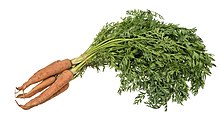แคร์รอต
แคร์รอต (อังกฤษ: carrot; ชื่อวิทยาศาสตร์: Daucus carota subsp. sativus) เป็นผักจำพวกรากที่โดยทั่วไปมีสีส้ม แต่ก็ปรากฏพันธุ์ปลูกสีม่วง ดำ แดง ขาว และเหลืองด้วย[2][3][4] ทั้งหมดนี้ได้รับการปรับปรุงพันธุ์มาจากแคร์รอตป่า (Daucus carota) ซึ่งมีถิ่นกำเนิดอยู่ในยุโรปและเอเชียตะวันตกเฉียงใต้
| แคร์รอต | |
|---|---|

| |
| การจำแนกชั้นทางวิทยาศาสตร์ | |
| โดเมน: | ยูแคริโอต |
| อาณาจักร: | พืช |
| เคลด: | พืชมีท่อลำเลียง |
| เคลด: | พืชดอก |
| เคลด: | พืชใบเลี้ยงคู่แท้ |
| เคลด: | แอสเทอริด |
| อันดับ: | อันดับผักชี |
| วงศ์: | วงศ์ผักชี |
| สกุล: | Daucus (Hoffm.) Schübl. & G. Martens |
| สปีชีส์: | Daucus carota |
| ชื่อทวินาม | |
| Daucus carota (Hoffm.) Schübl. & G. Martens | |
| ชื่อพ้อง[1] | |
| |
การผลิต
แก้| ประเทศ | ผลการผลิต (ล้านอันต่อตัน) |
|---|---|
| จีน | 17.9 |
| อุซเบกิสถาน | 2.2 |
| สหรัฐ | 1.5 |
| รัสเซีย | 1.4 |
| ยูเครน | 0.8 |
| ทั่วโลก | 40 |
| ข้อมูล: FAOSTATของสหประชาชาติ[5] | |
ใน ค.ศ. 2018 ผลผลิตของแคร์รอต (รวมกับหัวผักกาด) ทั่วโลกอยู่ที่ 40 ล้านตัน โดยจีนผลิตร้อยละ 45 ของทั้งโลก (ตาราง)[5] ส่วนประเทศที่เป็นฐานผลิตชั้นนำคือสหรัฐ, อุซเบกิสถาน และรัสเซีย[5]
การเก็บ
แก้แคร์รอตสามารถเก็บในดู้เย็นได้ไม่กี่เดือน หรือในที่หนาวชื้นทั้งฤดูหนาว สำหรับการเก็บในระยะยาว แคร์รอตที่ยังไม่ล้างสามารถใส่ในถังในชั้นทราย ทรายกับเปลือกไม้ครึ่งต่อครึ่ง หรือในดิน ช่วงอุณหภูมิที่ดีที่สุดคือ 0 ถึง 4 องศาเซลเซียส (32 ถึง 40 องศาฟาเรนไฮต์)[6][7]
อ้างอิง
แก้อ้างอิง
แก้- ↑ "Daucus carota subsp. sativus (Hoffm.) Arcang". theplantlist.org. The Plant List. คลังข้อมูลเก่าเก็บจากแหล่งเดิมเมื่อ 2020-10-03. สืบค้นเมื่อ 12 July 2020.
- ↑ Iorizzo, Massimo; Curaba, Julien; Pottorff, Marti; Ferruzzi, Mario G.; Simon, Philipp; Cavagnaro, Pablo F. (2020-08-07). "Carrot Anthocyanins Genetics and Genomics: Status and Perspectives to Improve Its Application for the Food Colorant Industry". Genes. 11 (8): 906. doi:10.3390/genes11080906. ISSN 2073-4425. PMC 7465225. PMID 32784714.
- ↑ Iorizzo, Massimo; Senalik, Douglas A.; Ellison, Shelby L.; Grzebelus, Dariusz; Cavagnaro, Pablo F.; Allender, Charlotte; Brunet, Johanne; Spooner, David M.; Van Deynze, Allen; Simon, Philipp W. (2013). "Genetic structure and domestication of carrot (Daucus carota subsp. sativus) (Apiaceae)". American Journal of Botany. 100 (5): 930–938. doi:10.3732/ajb.1300055. PMID 23594914.
- ↑ Sifferlin, Alexandra. "Eat This Now: Rainbow Carrots". Time. คลังข้อมูลเก่าเก็บจากแหล่งเดิมเมื่อ 23 January 2018. สืบค้นเมื่อ 27 January 2018.
- ↑ 5.0 5.1 5.2 "Production of carrots (and turnips; crops combined) in 2018, Crops/World Regions/Production Quantity, from pick lists". UN Food and Agriculture Organization Corporate Statistical Database (FAOSTAT). 2019. คลังข้อมูลเก่าเก็บจากแหล่งเดิมเมื่อ 2016-11-22. สืบค้นเมื่อ 18 August 2020.
- ↑ Gist, Sylvia. "Successful Cold Storage". Backwoods Home Magazine. คลังข้อมูลเก่าเก็บจากแหล่งเดิมเมื่อ 6 September 2011. สืบค้นเมื่อ 2013-03-21.
- ↑ Owen, Marion. "What's Up Doc? Carrots!". UpBeat Gardener. PlanTea. สืบค้นเมื่อ 2013-03-21.
วรรณกรรมที่ถูกอ้างอิง
แก้- Benjamin, L. R.; McGarry, A.; Gray, D. (1997). "The root vegetables: Beet, carrot, parsnip and turnip". The Physiology of Vegetable Crops. Wallingford, UK: CAB International. pp. 553–580. ISBN 978-0-85199-146-7.
- Bradeen, James M.; Simon, Philipp W. (2007). "Carrot". ใน Cole, Chittaranjan (บ.ก.). Vegetables. Genome Mapping and Molecular Breeding in Plants. Vol. 5. New York, NY: Springer. pp. 162–184. ISBN 978-3-540-34535-0.
- Rubatsky, V. E.; Quiros, C. F.; Siman, P. W. (1999). Carrots and Related Vegetable Umbelliferae. CABI Publishing. ISBN 978-0-85199-129-0.
- Simon, Philipp W.; Freeman, Roger E.; Vieira, Jairo V.; และคณะ (2008). "Carrot". Vegetables II. Handbook of Plant Breeding. Vol. 2. New York, NY: Springer. pp. 327–357. ISBN 978-0-387-74108-6.
แหล่งข้อมูลอื่น
แก้- วิกิคำคม มีคำคมที่กล่าวโดย หรือเกี่ยวกับ แคร์รอต
- วิกิมีเดียคอมมอนส์มีสื่อเกี่ยวกับ Daucus carota
- วิกิมีเดียคอมมอนส์มีสื่อเกี่ยวกับ แคร์รอต